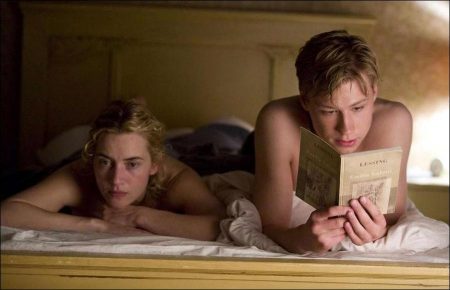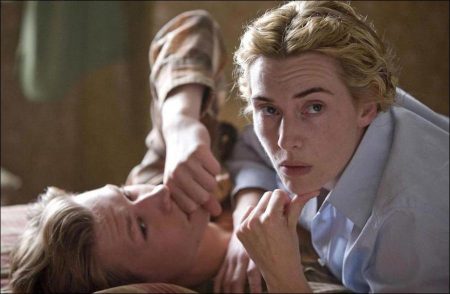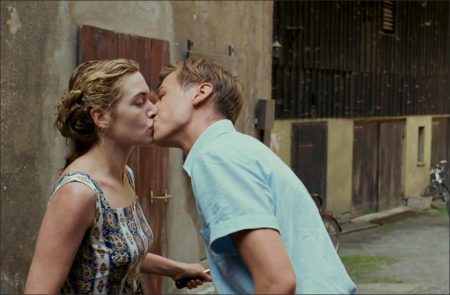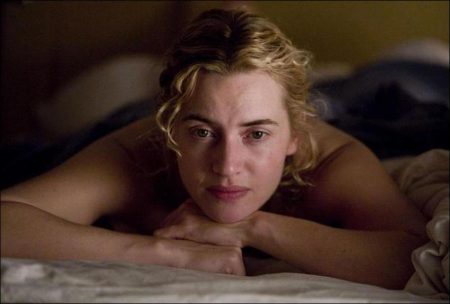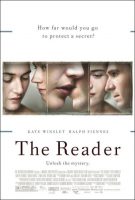Tagline: How far you go to protect a secret?
The Reader movie storyline. A haunting love story based on the best-selling novel of the same name, “The Reader” is set in postwar Germany and tells the story of a man whose life has been shaped by an illicit affair with a passionate older woman during his youth. Bernhard Schlink’s “The Reader” has been translated into 39 languages and has garnered numerous awards. “The Reader” was the first German novel to reach number one on The New York Times Bestseller List.
“The Reader” opens in post-WWII Germany when teenager Michael Berg becomes ill and is helped home by Hanna, a stranger twice his age. Michael recovers from scarlet fever and seeks out Hanna to thank her. The two are quickly drawn into a passionate but secretive affair. Michael discovers that Hanna loves being read to and their physical relationship deepens. Hanna is enthralled as Michael reads to her from “The Odyssey”, “Huck Finn”, and “The Lady with the Little Dog.” Despite their intense bond, Hanna mysteriously disappears one day and Michael is left confused and heartbroken.
Eight years later, while Michael is a law student observing the Nazi war crime trials, he is stunned to find Hanna back in his life – this time as a defendant in the courtroom. As Hanna’s past is revealed, Michael uncovers a deep secret that will impact both of their lives. “The Reader” is a haunting story about truth and reconciliation, about how one generation comes to terms with the crimes of another.
The Reader is a 2008 German-American romantic drama film directed by Stephen Daldry and written by David Hare, based on the 1995 German novel of the same name by Bernhard Schlink. Ralph Fiennes and Kate Winslet star along with the young actor David Kross. It was the last film for producers Anthony Minghella and Sydney Pollack, both of whom had died prior to release. Production began in Germany in September 2007, and the film opened in limited release on December 10, 2008.
From Book to Film
The compelling story of The Reader in many ways touches on the deeply transformative power of words and literacy. So it seems fitting that the film originated with a lyrically simple, yet emotionally jarring, book—“a formally beautiful, disturbing and, finally, morally devastating novel,” according to the Los Angeles Times.
Written by Berlin law professor and mystery novelist Bernhard Schlink, the semi-autobiographical work was published in 1995, later translated into 40 other languages, and became the first German novel to top the New York Times’ bestseller list, garnering widespread attention in 1999 after Oprah Winfrey chose the title for her popular book club. “Who would have guessed that a book only 218 pages long could stir up so many emotions?” asked Winfrey, who noted that more men read the novel than any of her other book club selections before it was discussed on her program.
“It’s a story about what we call ‘the second generation,’” says Schlink, describing “the lucky late-born” children of the post-war years. “We grew up in a very naïve way until, at some point, we realized just what our parents and pastors and teachers had done. When you love someone who has been engaged in something awful, it can entangle you.” In Germany, the movement towards comprehending the war even required its own psychological term—vergangenheitsbewältigung, meaning “the struggle to come to terms with the past.” The novel is considered so important to understanding the country’s history that it has even been used as a textbook in German schools.
Film rights to The Reader were acquired by Harvey Weinstein and Miramax Films in 1996. At Weinstein’s urging Anthony Minghella and his production partner Sydney Pollack became involved, with Minghella intending to both pen the screenplay and direct. But stage dramatist Sir David Hare, later to become an Academy Award nominee for his screenwriting work on The Hours, also read the Schlink book and yearned to adapt it. Since Minghella had just swept the Academy Awards with The English Patient and was mulling over several more epic projects, Hare tried to cajole him into handing over writing chores on The Reader, but Minghella remained determined to develop the script himself.
Nearly a decade later, with no screenplay completed, Daldy—who studied German as a boy and had lived in Berlin—began asking Minghella about the possibility of directing The Reader. Realizing it would be some time before he himself could become so involved with the production, Minghella agreed to let Daldry direct, with the provisos that it become Daldry’s next project, and that he and Pollack would stay on board as producers. As far as getting a screenplay, Daldry naturally thought of Hare. “We did The Hours, and so this is the second complicated and hugely ambitious film we’ve made together,” says Hare. “We’re very deeply bonded, much like people who have been to war together – we know each other’s strengths and weaknesses.”
Diverging from Schlink’s novel, which unfolds chronologically in three distinct segments, the screenplay version of The Reader “jumps through time,” in Hare’s words, with a structure that transports the viewer into the main character’s life at several different junctures from the 1950s through the 1990s and back again. A highly accomplished playwright, director and author weary of obedience to tradition, Hare struggles to revolt in his original works and he envisioned an exciting, fresh approach to his adaptation, without resorting to those “dreary old voice-overs” which often accompany first-person narratives.
“When I go to the cinema, I’m bored stiff by films whose shape and character I can predict from the moment I enter the theater,” says Hare, who was determined to unchain The Reader from the binds of previous WWII-aftermath films that dealt with concentration camps, postwar anxieties, and individual complicity in crimes committed by the state. “I’m only interested in things that don’t belong to any genre,” he says, adding, “This is most certainly not what can be called ‘a Holocaust picture.’”
“There have been 252 films made about the Holocaust,” says Daldry, “and I hope there are at least as many more.” But The Reader is something else, he believes, calling it “an odd piece” that belies expectations. Bucking the trend of previous survivor stories, a character revealed late in the film who made it through the camps alive is portrayed as a pillar of moral and intellectual strength as opposed to a weakened victim.
While Hare, Daldry, Minghella and Pollack understood the value of cinematic innovation and experimentation, one aspect of the project never wavered—respect and honor for those victims of Nazi war crimes. There was an understanding among the principals that the term “forgiveness” would not be mentioned—the film, in fact, avoids vague notions of redemption or forgiveness but, instead, deals with the very real problem of how a new generation comes to terms with its tarnished past.
To this end, both the screenwriter and the director toured Germany with author Schlink to discuss post-war guilt and the contentious reactions his novel provoked. “The book is of huge historical significance in Germany,” says Daldry. “It is the singular novel addressing the problem of ‘How do we continue after what we have done?’”
“It attracted both the most extraordinary praise and the most violent attacks,” adds Hare. “Trying to explore and understand Nazi crimes is a dangerous and volatile business—you can unintentionally cross a line that you don’t wish to.”
Determined to explain “how the children of a criminal generation lived with the consequences” of their parents’ misdeeds, Daldry was uncompromising. “The film tackles war crimes head on,” says the director, careful not to depict concentration camp guards as horrific ogres or outré villains but, rather, as average workers and local neighbors. “It exposes ordinary people who commit these crimes—the banality of evil.”
Unlike many screenwriters whose input stops after they deliver the final draft of their script, Hare was again welcomed into the filmmaking process by Daldry, just as he was on THE HOURS.
“Stephen allows me to be a collaborator from the beginning of filming to the end of editing,” says the dramatist. “He won’t work with people who are not committed to collaboration at a profound level. In that sense, it’s more like working in theatre than film. He is the most thorough director I’ve ever worked with—nothing passes through the lens by chance.”
As for the original author, Schlink too participated in ways he might have never imagined—even appearing as an extra in an outdoor beer garden scene where ill-fated lovers Hanna and Michael have lunch during a bicycling holiday. It was there he saw Daldry’s obsessions with accuracy and honesty down to the smallest, slightest detail, whether it involved a period prop or a quick glimpse by one of the actors. “Stephen has a sensitivity for the most tiny, subtle things, and that’s something I greatly admire.”
Continue Reading and View the Theatrical Trailer
The Reader (2008)
Directed by: Stephen Daldry
Starring: Kate Winslet, Ralph Fiennes, Alexandra Maria Lara, Bruno Ganz, Linda Bassett, Karoline Herfurth, Susanne Lothar, David Kross, Florian Bartholomäi, Friederike Becht
Screenplay by: David Hare
Production Design by: Brigitte Broch
Cinematography by: Roger Deakins, Chris Menges
Film Editing by: Claire Simpson
Costume Design by: Donna Maloney, Ann Roth
Set Decoration by: Karin Betzler, Eva Stiebler
Art Direction by: Anja Fromm, Christian M. Goldbeck, Stefan Hauck, Erwin Prib, Yeşim Zolan
Music by: Nico Muhly
MPAA Rating: R for some scenes of sexuality and nudity.
Distributed by: The Weinstein Company
Release Date: December 10, 2008
Views: 97
